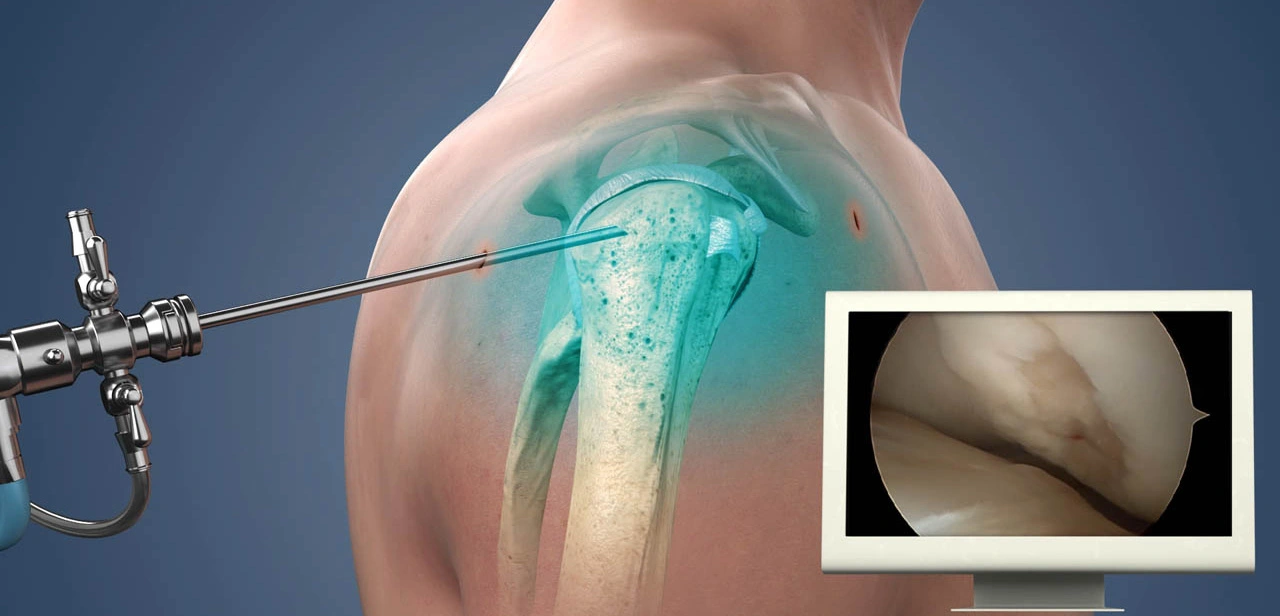Arthroscopy for Frozen Shoulder treatment surgery cost Indore
Frozen shoulder (also known as adhesive capsulitis) causes stiffness in the shoulder, making it painful and difficult to move the shoulder normally. In serious cases, patients may not be able to move their shoulder at all, even with the help of another person. If you are experiencing stiffness or pain in your shoulder, the team at California Orthopedics & Spine in Novato, CA, may be able to help.
The shoulder is a ball and socket joint. Strong connective tissue, called the shoulder capsule, surrounds the joint of the shoulder. In a healthy shoulder, fluid lubricates the capsule and the joint within. When frozen shoulder develops, the tissues that make up the shoulder capsule tighten and become thicker. In some cases, the fluid that once lined the shoulder can also start to diminish. The capsule can start to develop stiff bands of tissue, called adhesions, which limit shoulder movement.

The reason why certain people get frozen shoulder is not always clear. Individuals in their 40s–60s are most likely to experience frozen shoulder. Women are slightly more likely than men to develop the condition. Certain pre-existing conditions, such as diabetes or Parkinson’s, can also increase the likelihood of developing frozen shoulder.
Injuries that require the shoulder to be immobilized for a time can also contribute to the development of a frozen shoulder.
Frozen shoulder develops in three stages: freezing, frozen, and thawing.
- During the freezing stage, you start to lose your range of motion, and your shoulder develops more and more pain over time. The freezing can worsen for anywhere from six weeks to nine months.
- In the frozen stage, pain may improve, but the stiffness in the shoulder will continue, making some daily activities very difficult. Usually, the shoulder will stay frozen for about four to six months.
- The thawing stage is when shoulder movement starts to improve. Mobility should slowly improve for six months to two years. Your strength should also start to return.
Usually, nonsurgical treatments are effective in treating frozen shoulder.
- Medications to control pain and inflammation can help reduce swelling and discomfort. For severe pain, steroid injections contain more powerful medicines that can help reduce inflammation and control pain.
- Physical therapy is very important to restore motion in the shoulder. In fact, after a shoulder injury or surgery, physical therapy is often recommended to prevent frozen shoulder from developing. Specific stretches and exercises can be especially helpful in returning a person’s range of motion and strength.
Treatment can take anywhere from a few months to years to restore full motion. When nonsurgical methods are not successful, you and your doctor may talk about surgical treatment options. If surgery is recommended, you will likely have one or both of the following surgical procedures:
- Manipulation under anesthesia is a procedure where your doctor will force the shoulder to move, stretching or tearing the scar tissue and loosening the tight joint capsule. You will be under anesthesia throughout the entire surgery, to prevent any pain during the stretching of the tissue.
- Shoulder arthroscopy is another option that allows for more controlled alteration of the tight tissue. Tiny tools will be inserted into the shoulder through small incisions, making the procedure less invasive than a full open surgery. Your doctor will cut through the tighter bands of tissue to loosen or unfreeze the shoulder.
Regardless of the treatment you receive, physical therapy will likely be a part of your recovery plan to prevent recurrences and improve your range of motion.
Frozen Shoulder Treatment in Indore, India
If you are experiencing frozen shoulder, difficulty moving your shoulder, or other issues, Dr. Ravindra Gupta is here to help. We can evaluate your condition to help you find a treatment plan that fits your needs. Contact our office to schedule an exam and start moving toward treatment for your shoulder pain.
